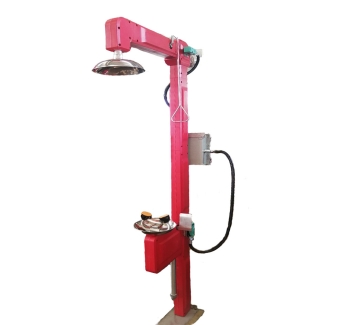Emergency eyewash properties
Material: Stainless steel
Style: Manual/pedal type
Properties: Anti-oil, anti-acid, alkali, salt solution
Water output: shower head 120-180 L/min
Eye washer nozzle 12 L/min
E
yewash stations with heater emergency shower system System composition:
An eyewash station with a heater emergency shower system mainly consists of the following parts:
Shower system: includes shower head and corresponding plumbing system for providing full body flushing.
Eye washer: Equipped with eye wash nozzle and corresponding control system for rinsing eyes.
Heater: Used to heat the flushing water to ensure that the water temperature is within the appropriate range to avoid secondary injury to the injured person caused by cold water.Anti freeze Emergency shower eye wash station
Water supply device: Provides a stable water source for shower system and eye wash.
Control system: used to control the heating temperature of the heater, the opening and closing of the shower system and the eye wash.
Working principle:
In the event of an emergency, the injured person can quickly reach the eye wash station and activate the shower system or eye wash as needed. The heater heats the flushing water according to a preset temperature range to ensure that the water temperature is appropriate. The shower system flushes the whole body, while the eye washer focuses on flushing the eyes, both working together to provide comprehensive flushing and cleaning for the injured.
An emergency sprinkler system usually consists of the following parts:
Spray head: Located at an easily accessible height, usually above eye level, so that personnel can quickly access and use in an emergency. The spray head is designed to provide a large flow of water, covering the whole body.
Water supply line: Connect the sprinkler head to a water source (such as a tap system or a separate water storage tank) to ensure that sufficient water and pressure can be provided in an emergency.
Activation mechanism: It is usually manually operated, such as pulling a rope or handle, to trigger the water flow.sampling system In some designs, an automatic sensing device may also be included that automatically activates when a specific chemical or temperature is detected.
Drainage system: Ensure that the waste water can be quickly discharged after use to avoid secondary damage or pollution caused by water.
Indication sign: Clearly visible indication sign to help personnel quickly locate the spray device in an emergency.
An emergency sprinkler system usually consists of the following parts:
Spray head: Located at an easily accessible height, usually above eye level, so that personnel can quickly access and use in an emergency. The spray head is designed to provide a large flow of water, covering the whole body.
Water supply line: Connect the sprinkler head to a water source (such as a tap system or a separate water storage tank) to ensure that sufficient water and pressure can be provided in an emergency.
Activation mechanism: It is usually manually operated, such as pulling a rope or handle, to trigger the water flow.sampling system In some designs, an automatic sensing device may also be included that automatically activates when a specific chemical or temperature is detected.
Drainage system: Ensure that the waste water can be quickly discharged after use to avoid secondary damage or pollution caused by water.
Indication sign: Clearly visible indication sign to help personnel quickly locate the spray device in an emergency.
An emergency sprinkler system usually consists of the following parts:
Spray head: Located at an easily accessible height, usually above eye level, so that personnel can quickly access and use in an emergency. The spray head is designed to provide a large flow of water, covering the whole body.
Water supply line: Connect the sprinkler head to a water source (such as a tap system or a separate water storage tank) to ensure that sufficient water and pressure can be provided in an emergency.
Activation mechanism: It is usually manually operated, such as pulling a rope or handle, to trigger the water flow.sampling system In some designs, an automatic sensing device may also be included that automatically activates when a specific chemical or temperature is detected.
Drainage system: Ensure that the waste water can be quickly discharged after use to avoid secondary damage or pollution caused by water.
Indication sign: Clearly visible indication sign to help personnel quickly locate the spray device in an emergency.


